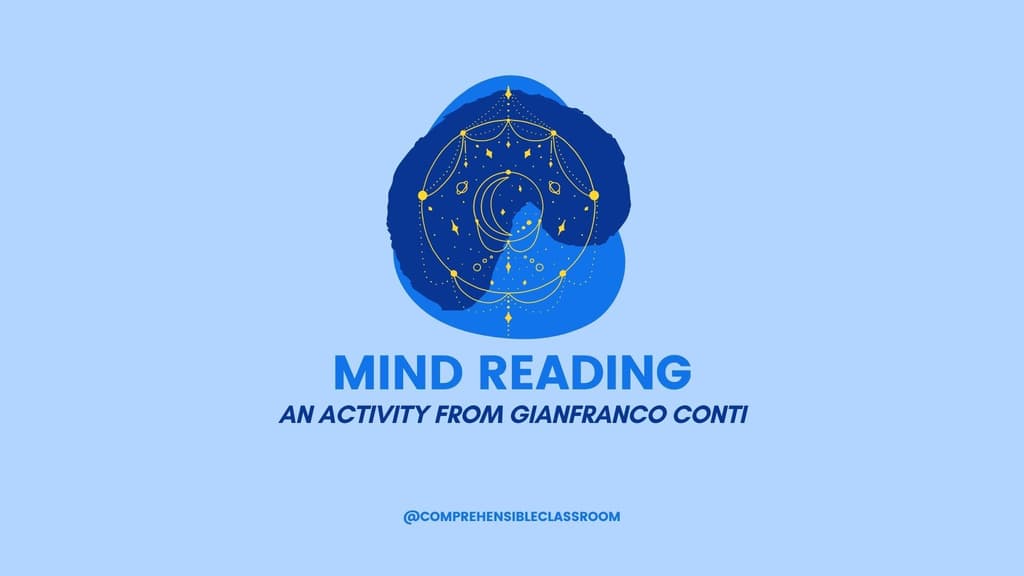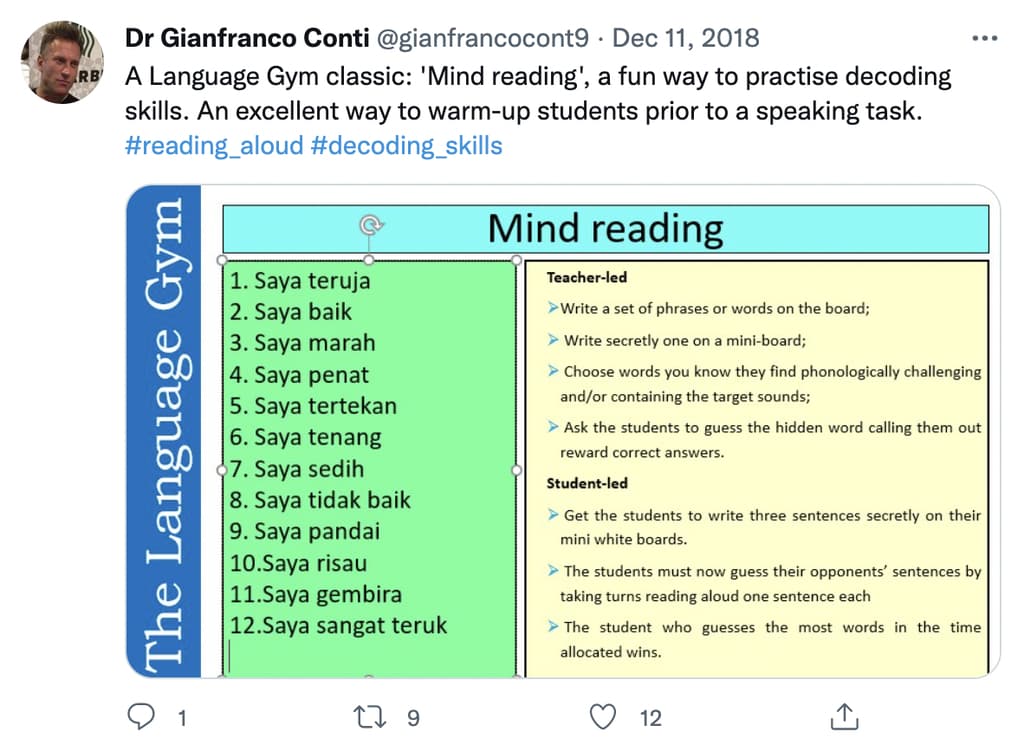If you are in need of a low-prep, low-key interpretive activity, Mind Reading is for you! Mind Reading is a Language Gym activity from Dr. Gianfranco Conti. Dr. Conti and his colleague and frequent partner-in-crime, Steve Smith, have taught me much through their shared resources, training materials, and critical questions over the years. Mind Reading is a great example of what you can expect from The Language Gym - a skill-based activity that fits easily into a Comprehension-based approach to language teaching.
Let's check it out!
Mind Reading - from The Language Gym
Here is a tweet that explains Mind Reading from the creator himself, Dr. Gianfranco Conti!
The basic premise of the activity is that students are reading a list of words, phrases, or sentences and trying to guess which one has been secretly chosen as the Secret Sentence/Word by the person guiding the activity. While there are a variety of ways that you can use this activity to focus on different skills, I love to make it as communicative and input-focused as possible– and that is what I will walk you through in this blog post.
Class Mind Reading
The first step of Mind Reading is to gather a list of sentences! Write out a list of 5-15 sentences on your board. These sentences could come from any number of sources. Here are some ideas:
Personalized sentences
Have you tried out Special Person Interviews or Weekend Chat or done a round of Personalized Questions and Answers with your students? If so, you've got the perfect foundation laid for a round of Personalized Mind Reading. Write down sentences that your students ACTUALLY said through the course of your conversations or that they could have said, based on the information you learned from talking with them about their lives.
Themed sentences
Write out a bunch of original sentences that hinge on a single theme or use a similar pattern. This could be something like, "I like pizza", "I like grapes", "I like pancakes". Another option might be, "Soccer is my favorite sport", "Football is the most challenging sport", "Golf is a sport", etc.
Sentences from a text
Choose a familiar narrative or informational text. This could be the text that you generated during a Write and Discuss of your class story, a portion of a novel that you've been reading, a biography, a story from Somos Flex or El mundo en tus manos, a Garbanzo lesson... anything! Heck, it could even be an unfamiliar text as long as it is understandable to your students. Choose your 5-15 sentences from your chosen text!
Whatever you choose as your source, project the sentences on the board and then continue on with the activity in class!
Step 2: Model student chooses a secret sentence
Have ONE of your students choose ONE of the sentences on the board. Give them some direction, like "Your favorite response", "Something that you agree with/is true about you", "Something that you disagree with/is not true about you", "The most interesting response", "The scariest/funniest/prettiest sentence" ... something like that. Asking a question that is a little playful and/or helps students to think about the information in a different way can help to capture students' interest and encourage them to really attend to the meaning of the sentences. Have this student copy down the sentence onto a slip of paper and hand the paper to you for safekeeping.
Step 3: Classmates give mind reading a try
Then, have students in the class try to guess which sentence that student selected as their answer to your question. Their goal is to Read the Mind of the student that had just chosen a secret sentence!
Step 4: Review the options
To generate further input from this activity and create an opportunity for play/playfulness, read through the list of sentences one at a time, out loud. Make sure that all of your students understand every sentence (using techniques like these), and interact with your model student. If you have a student that likes joking around, you might ask a question like, "Jamie, do you think that "I worked for 8 hours" the prettiest sentence?" "Do you think that "I worked for 8 hours" is prettier than "I went to my grandma's house?". The student would try to deceive their classmates by saying, "Yes", "No", or "Maybe". If your model student wouldn't really enjoy that interaction, then ask the class those questions to reflect on their answer.
Step 5: Classmates state their guesses
Before moving on to the reveal, get a final vote for which sentence your students think is the Secret Sentence. You can do this by having all students record their responses on a white board and holding them up at the same time, by asking for cheers or raised hands as you list of each sentence or sentence number, or by collecting answers in a digital space such as Jamboard.
Step 6: Reveal the secret sentence
Once you've reviewed together all the sentences and students have shared what they saw in the mind of the model student, it's time for the big reveal! Open up the slip of paper that the secret sentence was recorded on, and read it aloud for the class.
Award points or words of celebratory praise to your successful Mind Readers!
Class Mind Reading: Teacher's sentences
Team Mind Reading
Turn Mind Reading into a game! Divide your class into two or more groups. On each turn, bring up a student from a different team. Their goal is to foil the Mind Readers on the other team! After they pick their secret sentence, the other teams confer to attempt to guess which sentence the model student chose.
Give each team three guesses, and have them write them down, numbered 1-3. If they guess the Secret Sentence as their #1 guess, they get 20 points. If it's their #2 guess, they get 10 points. #3 guess gets 5 points! The team that is represented by the model student can also earn points - 10 points for any team that DOESN'T write down their Secret Sentence as any of their three guesses (if there are 4 teams playing, the model student's team could earn up to 30 points, if all three other teams do not guess the Secret Sentence).
Partner Mind Reading
One more twist is Partner Mind Reading! Pair students up and make sure that each one has access to a text or a list of sentences. Partner A picks one sentence and writes it down, and Partner B then tries to guess it in 3 tries or fewer. Then, Partners switch roles.
You could play several rounds with the same partners, or you could have students rotate to new partners after each turn using a structure like Inside/Outside Circles or Stand Up, Hand Up, Pair Up.
What makes Mind Reading great?
No matter how you choose to play, Mind Reading is not only great fun, but also great for language acquisition when the sentences are chosen carefully.
Always prepare your sentences with two thoughts in mind:
- Can all of my students understand these sentences with ease, possibly with support from me?
- Are these sentences about a topic or from a source that is reasonably interesting to my students?
If students are 'playing to win' (actually trying to 'read the mind' of their classmate), they will be engaged in meaning making. They will not just be picking sentences randomly and hoping that it matches the Secret Sentence, but they will instead be thinking of what they know about their classmate and matching that knowledge to the information in the sentences to make their guess. Certainly, this won't happen every time– but attending to the two criteria above (is it comprehensible and is it interesting) will help make meaning-making come naturally.
More like this
Give Dr. Conti's Mind Reading a try, then check out these other games and interpretive activities that share similar qualities!






